The Other Side of the Door (2016)
Directed by: Johannes Roberts
Written by: Ernest Riera, Johannes Roberts
Starring: Javier Botet, Jeremy Sisto, Sarah Wayne Callies, Sofia Rosinsky
UK/ India
IN CINEMAS NOW
RUNNING TIME: 96 min
REVIEWED BY: Dr Lenera, Official HCF Critic
Everything seems fine with Michael and Maria’s new life in Mumbai, India, until their son Oliver dies in a horrific accident, causing Maria to struggle with untold grief, guilt, and shame, even lashing out at her family. Her Indian housekeeper, Piki, who once lost a child herself, suggests that Maria should visit the abandoned temple of Piki’s old village, where, as rumour and superstitious folklore have it, the worlds of the living and the dead are closer than anywhere else, in order to talk to her son one last time and tell him goodbye. Maria has to spread the ashes of her son on the steps of the temple, close the door behind her and wait for her son’s spirit to talk to her from beyond the door. And whatever he says, no matter how hard he pleads, Maria is warned not to open the door, under pain of disastrous consequences. But this is a horror movie, so Maria opens the door, and her house soon appears to be haunted by the presence of her son….
Clearly influenced by Pet Cemetery, something this film isn’t at all ashamed of as it even has a dog named Winston, The Other Side Of The Door seems to have also received a rather negative overall critical response, though also browsing through the user reviews on the IMDB revealed that it seems to be more liked by general viewers. In any case, I quite enjoyed it. Maybe that was partly because last week’s The Forest was such a classic case of wasted potential in a movie that half-heartedly tried to go in several different directions at once and, one or two good moments aside, wasn’t really very frightening at all, at least to this critic. I’m going to say right now that the latter problem is certainly not something that I found with The Other Side Of The Door. How, why and when a particular filmgoer finds a particular movie scary probably can’t be fully explained, but this viewer certainly didn’t feel the need to try to get himself to ‘that place’ where he can more easily be frightened with this movie. For that reason alone, The Other Side Of The Door deserves some respect, even if some considerable flaws, such as lazy plotting and, again, that thing called wasted potential, are obvious even when you are watching it, let alone after it’s finished and you’re attempting to type your thoughts into a coherent review.
The story hinges largely on grief, which has been a strong basis for horror films all the way back to, and probably beyond, Don’t Look Now. The recent The Babadook dealt with the subject in a highly effective way. The Other Side Of The Door is genuinely sad during much of its opening act, partly because Sarah Wayne Callies gives such a strong performance in the lead role without overdoing the hysterics, though a flashback showing the circumstances of her character’s son’s death would have hit harder without the employment of shakycam so it’s hard to make out exactly what’s going on. The film also seems to be in a bit of a rush to get to the scary bits, almost as if some material has been removed. Certain events later on in the film don’t have much impact because of no lead-in to them. A budgie dies, but it almost comes out of nowhere and we don’t feel much because the film never showed us the bird when it was living. Maria’s garden turns an autumnal brown and everything in it seems to die or be dying overnight due to the spreading of evil, but because we never previously got a sense of its previous lushness, it has little impact.
I’m getting ahead of myself though, and after about twenty minutes The Other Side Of The Door gets rather effective. I haven’t seen any of writer/director Johannes Roberts’s other work like Storage 24 and Hellbreeder, but judging by The Other Side Of The Door, to use a common phrase, he knows what scares. As is the fashion these days, it’s still mainly obvious build-ups to jump scares, and there’s nothing truly disturbing or shocking, but Roberts shows himself to be expert at pacing and timing. When Maria visits the temple where she may talk to and say a proper farewell to her son, a scene which already carries some foreboding due to the arid and deathly landscape she has to travel across, there’s a real sense of fear as Roberts commendably takes his time with the sequence, dwelling on unsettling details like an Indian deity with his or her hands covering his or her face, presumably because of intense fright, and the sound of lots of ghosts screaming to be let in really packs a frission, even if it would have worked better if it had been done in a quieter, calmer fashion. I was so happy that the movie was working for me in the way that it ought to at this point, but I also felt like crying when Maria talks to Oliver through the door, especially when Oliver begs for her mother to open it. Now even horror fans will admit that the genre thrives on [in fact, it would barely exist] characters behaving stupidly, often to the point that one feels like crying out to them to not investigate that odd noise in the loft, or go for a walk on their own when there’s a mad killer about. Maria is a bit of an idiot for opening the door because she’s been warned not to, but the scene has a certain amount of power because the viewer is made to feel some of the emotion she’s feeling, and because wouldn’t some of us do the same?
Oliver soon appears to be haunting the house, and Maria seems rather happy with the fact, but his innocent requests for bedtime stories and playtime with his sister become increasingly creepy and violent as the days go by. Not only that, but some mysterious Aghori tribesmen, whose traditional worship of the Hindu god Shiva includes rituals where they cover themselves in the ashes of the dead, begin to lurk around Maria’s house and follow her around Mumbai. More creepy though are some the simpler, quieter moments set in the house, Roberts getting a great deal of mileage from, especially, a stuffed tiger appearing in different places. And it’s been a while since I’ve seen the hoary old, but still eerie, device of a piano being mysteriously played, though the effect was lessened somewhat by the piece being played being the one that features in that classic bonding scene between Tom Hanks and Robert Loggia in Big. Unfortunately, as with many films of this kind, The Other Side Of The Door relies on some major contrivances, such as, for example, Maria’s husband being continually out of the way so that he, and then the viewer can, at least for a few moments, think that his wife is going insane, and eventually it becomes obvious that the tale isn’t going to get as interesting as it should do, though at least the conclusion has a nice sense of dark irony about it.
Unlike it seems some other reviewers, I don’t think that the film is racist –rather, it just exploits the feeling of living in a country very different to your own with a culture that is strange and sometimes frightening, and is basically about some silly white people who do the wrong thing, upset the locals, and then pay for it – but it only really touches on the Hindu folklore that underpins the story. It’s obvious that Roberts didn’t do much research, and, while he knows how to keep a viewer on edge and make him or her often react in the way someone watching a horror film should do, he relies too much on familiar sights and sounds, from Sinister to various J-Horror efforts, which many horror fans are probably sick of, while he’s not always that strong at writing. The Other Side Of The Door would have benefitted considerably from a do-over of the screenplay by somebody else. And the film’s propensity for shaky camerawork and jagged editing during its exciting moments means that it wastes its [ficticious] Hindu goddess Mrytu. We get a fairly good look at her when she’s a statue, but the really rather cool looking creation [and it’s a guy in a suit, too] is hard to make out when she’s alive, and the filmmakers also ruin much of her effect by having her move and sound just like Kayako from The Grudge.
Young Sofia Rosinski is very convincing in her role as Lucy and makes a few rather upsetting moments pack quite a punch. In fact the acting in this movie is good all round. The Other Side Of The Door could have been a lot better, and it does contain many of the things that are far too prevalent in screen horror these days, like scares which turn out to be dreams and excessive use of loud noises, but it manages to end up seeming both fresh and tired at the same time, which is some feat but one worthy of some praise in today’s climate. It does have an emotional edge which gives it some weight, and which will probably stay with me far longer than all the BOO stuff. Overall, it’s a reasonably decent, if in the end, unremarkable, horror flick which should provide a modicum of satisfaction as long as you don’t expect too much.
Rating: 










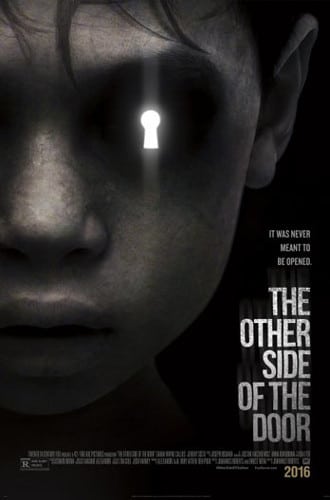
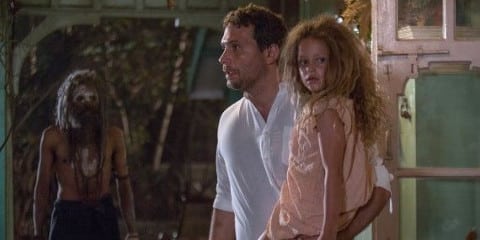
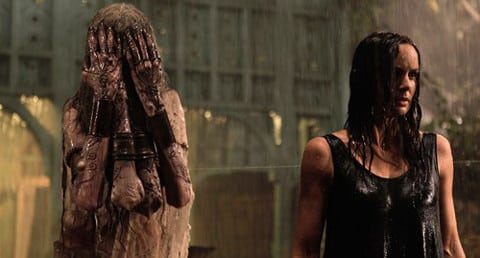

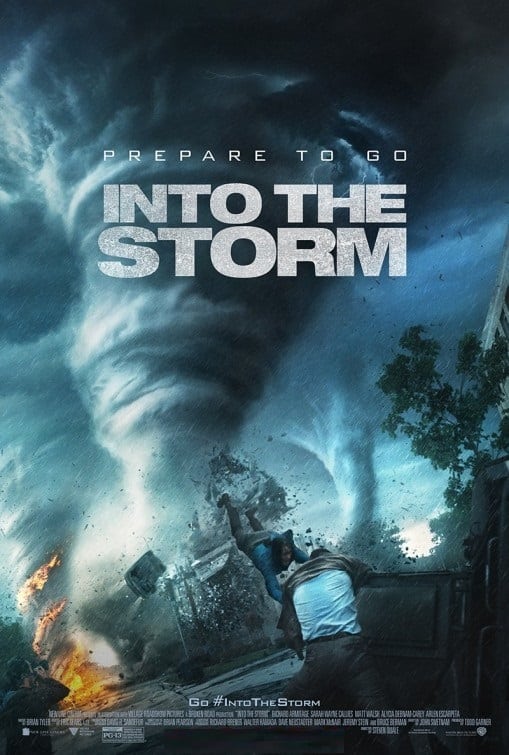
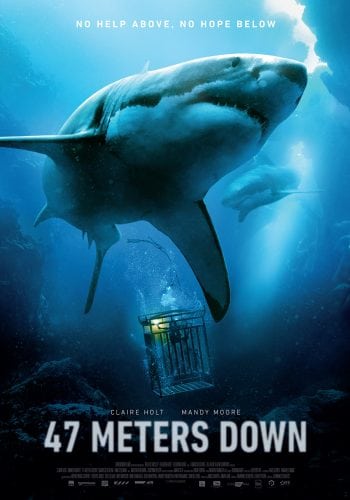

Be the first to comment